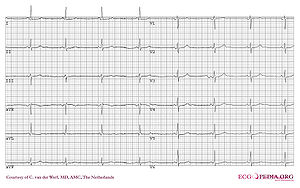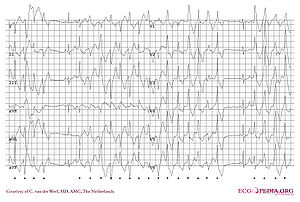Catecholaminergic Polymorphic Ventricular Tachycardia: Difference between revisions
Jump to navigation
Jump to search
mNo edit summary |
mNo edit summary |
||
| Line 6: | Line 6: | ||
|editor= | |editor= | ||
}} | }} | ||
[[File: | [[File:ECG000032.jpg|thumb|300px|right|The ECG of a patient with CPVT in rest is normal]] | ||
[[File: | [[File:ECG000033.jpg|thumb|300px|right|The ECG of the same patient with CPVT during exercise. Asterisks mark polymorphic ventricular beats.]] | ||
'''Catecholaminergic Polymorphic Ventricular Tachycardia''' is a congenital disease that leads to exercise induced [[Ventricular Arrhythmias|ventricular arrhythmias]] and / or syncope and carries an increased risk of sudden death. | '''Catecholaminergic Polymorphic Ventricular Tachycardia''' is a congenital disease that leads to exercise induced [[Ventricular Arrhythmias|ventricular arrhythmias]] and / or syncope and carries an increased risk of sudden death. | ||
Revision as of 21:40, 12 January 2010
| Author(s) | J.S.S.G. de Jong, MD | |
| Moderator | P.G. Postema, MD | |
| Supervisor | ||
| some notes about authorship | ||
Catecholaminergic Polymorphic Ventricular Tachycardia is a congenital disease that leads to exercise induced ventricular arrhythmias and / or syncope and carries an increased risk of sudden death.
Characteristics of CPVT:
- The mean onset of arrhythmias is 7-9 years
- Absence of structural cardiac abnormalities
- Normal resting ECG
- Syncope during physical activity or emotional stress
Diagnosis
- The diagnosis is based on reproducible ventricular arrhythmias during exercise testing. Typically the onset of ventricular arrhythmias is at around 100-120 bpm. The complexity of these arrhythmias often increases with increasing work load, starting with Ventricular Premature Beats, bidirectional ventricular tachycardia to polymorphic ventricular tachycardia.
- Two genes have been linked to CPVT. Both lead to a defect in intracellular calcium metabolism:
Treatment[1]
- Beta-blockers
- ICD implantation combined with beta-blockers in CPVT patients who survived a cardiac arrest.[2]
- Avoid competitive and other strenuous exercise
External Links
References
Error fetching PMID 16935995:
Error fetching PMID 12482795:
Error fetching PMID 12482795:
- Error fetching PMID 16935995:
- Error fetching PMID 12482795:

